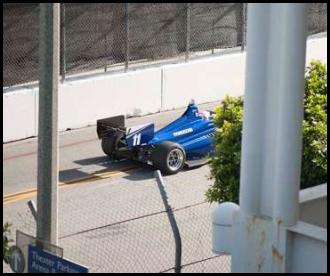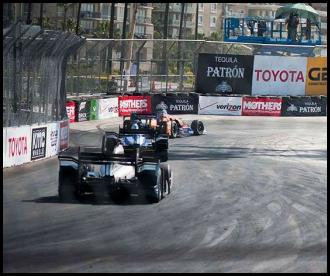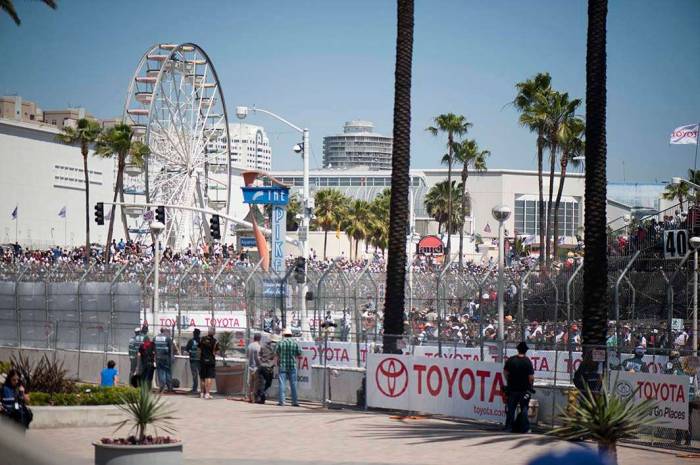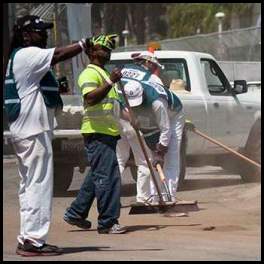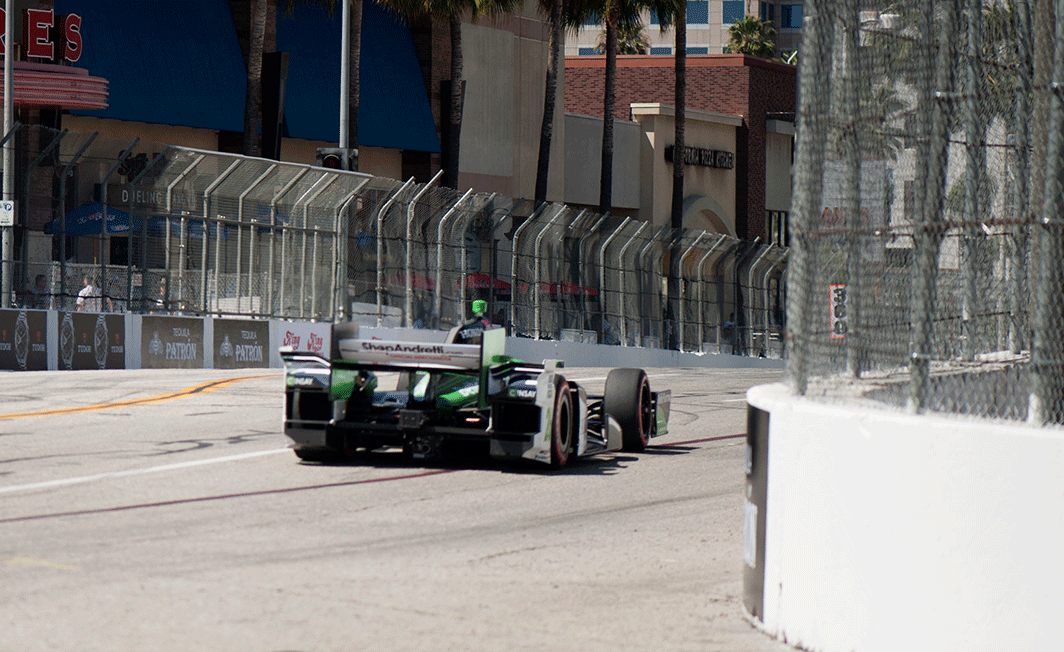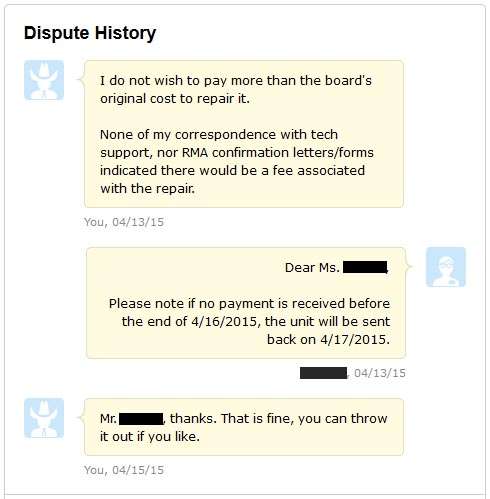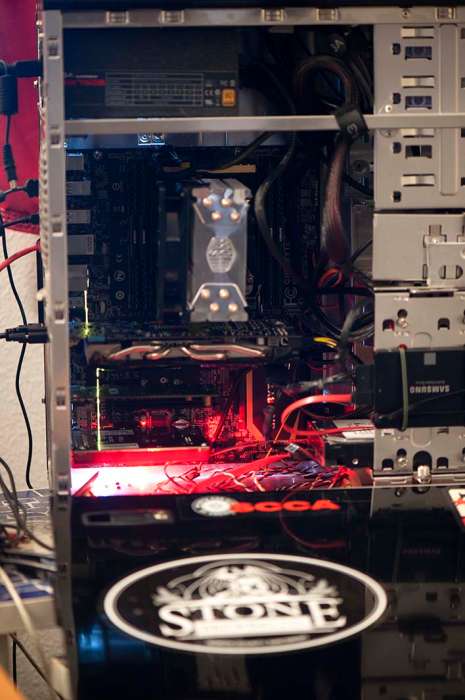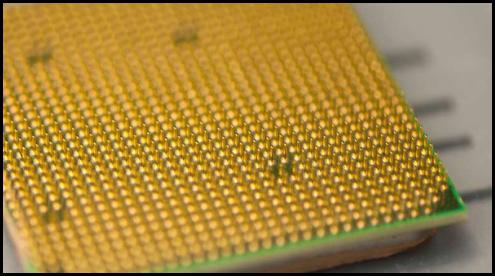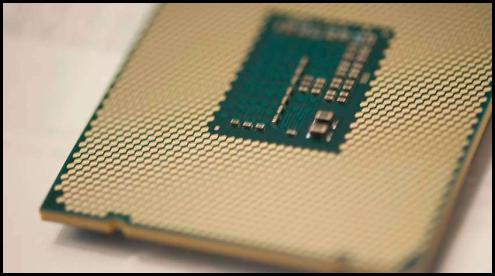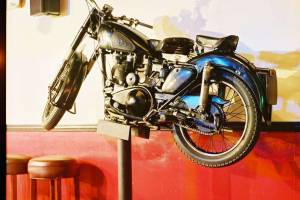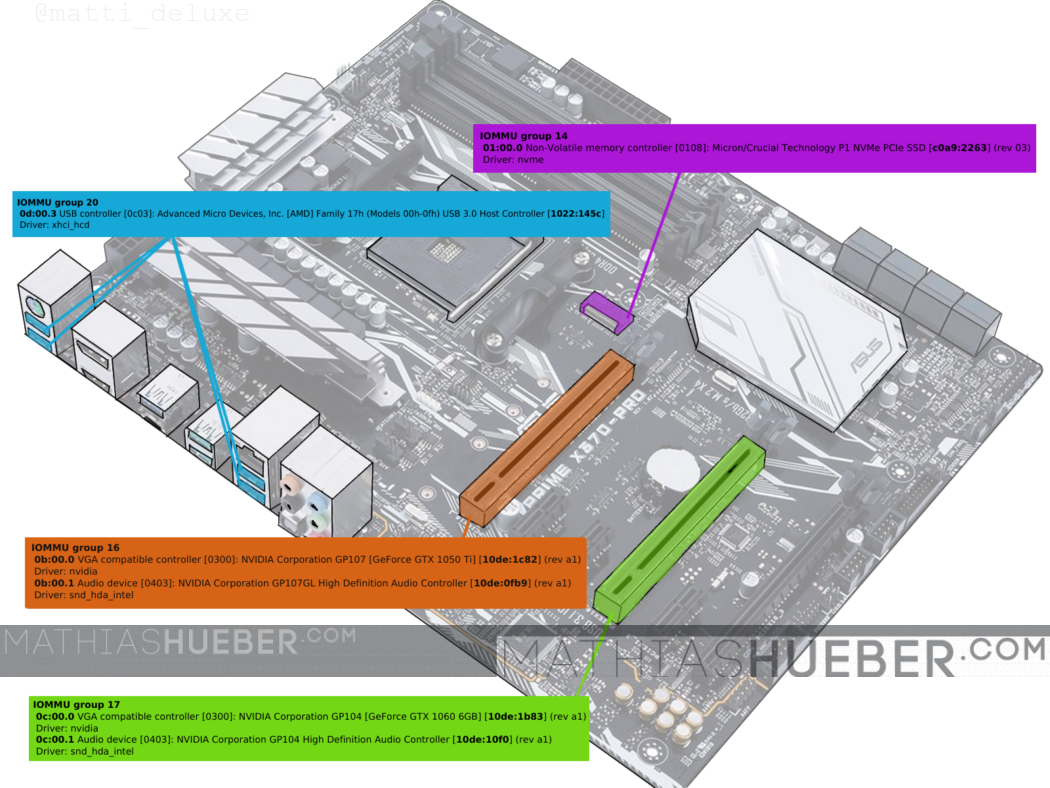Long Beach Grand Prix
This past Christmas Santa brought me a ticket to the
Long Beach GP. It's kind of a shame that in over a decade of SoCal living, I hadn't yet attended.
And I have really been missing out.
I arrived in time to see a good portion of the support race, even managing to catch an ill-advised pass that resulted in
safety car. After that was Indy practice, during which I toured as much of the track as possible.
The place is huge! And yet the top class can lap it in just over a minute.
It doesn't really impact viewing (except by adding safety safety), but
photography is made somewhat difficult by the two layers of fencing between the spectators and track. Still, it was a great chance to do some panning.
There are a few ways to get an
unobstructed shot:
- Escape roads have no safety fencing, so you just need to reach above the crowd barrier.
- There are plenty of places to view from elevation.
- The safety fences have (media) photographer windows, but you still have to shoot over/through the crowd barrier.
Still, you can always find a spot on any length of track to get right up to the crowd barrier, meaning you're six inches of concrete and five feet of air from the race. It is quite different from tracks with their pretentious 'run off room'.
The location affords some excellent
diversions. The convention center is full of exhibits and vendors, the marina provides a nice backdrop, and various restaurants provide an alternative to the booth food. Since the GP hosts a variety of races (Indy, Pirelli World Challenge, American LeMans, drift, historics, celebrities...), there is a spectrum of vendors and attendees.
On the subject of race variety, I noted
an offroad event. I found that strange since a street circuit is about as on-road as can be. Maybe they had hauled in a dirt track or something?
Who needs to haul in dirt when you can haul in
ramps and have trucks jump off of them? It was a pretty cool race (actually two or three heats). It wasn't an exhibition, they were really racing (dude on two wheels below was during the victory lap). And the ramps were required, drivers I think had to give up a position if they missed one.
For the main event, I started at the outside of the lovely
fountain chicane but moved around to a bunch of the corners I had scouted.
Checking out the shots later on, I found a pretty good example of how inch-perfect top tier race drivers are.
Kafka's sixth
New rig: origin story
My pc has been acting up for a while now. The greentext version excerpted from an email:

|
> Computer freeze was happening after lots of uptime, or restarting after lots of uptime.
> Overheating??? But really, could be anything, drivers, shitty services, whatever. Seemed to sometimes coincide with windows starting delayed services.
> Thought I had figured it out when I caught Windows update idly sitting on 500 megs of memory.
> Downloaded a temperature reader app, reapplied thermal grease to the cpu-heat sink connection.
> Was getting 127C on "temp3" device, cpu and graphics card well within spec.
> WTF is temp3?
> Touched a bunch of stuff. One heat sink was really hot.
> Mobo docs: nvidia on-board graphics card.
> WTF I have a pcix card
> Windows says pcix working fine, can run dual displays and skyrim.
> Also, why would the stock heat sink not be sufficient for the chip it's on?
> To BIOS to disable.
> Can disable pcix but not onboard.
> Device manager - no drivers installed for nvidia onboard devices.
> Install.
> Heat sink cools down.
> Fucking a.
|
Fucking a, indeed. After the driver install the gpu would bounce down to cooler temperatures, it stayed at MAX_VALUE most of the time and
still ended in a crash. The web didn't have much to say about the matter, so I tried my hand with ASUS tech support.
For starters, their support request form wants to make sure you're
really serious.
Everything is a required field. Model number and driver version for every last piece of silicon.
Aha, ASUS, I will not be deterred that easily!
[Product Information]
Product Type : Motherboard
Product Model : M3N78 Pro
Product S/N : 88moac821834
Date of Purchase : 2007/06/01
[Motherboard Specification]
Motherboard Revision : 0386
Motherboard BIOS Revision : 1404
[VGA Card Specification]
VGA Card Vendor : nVidia
VGA Card Model : GeForce 9800GT
VGA Card Chipset : GeForce
VGA Card Driver : 8.15.11.9038
[CPU Specification]
CPU Vendor : AMD
CPU Type : Phenom 8650
CPU Speed : 2.3G
[Memory Specification]
Memory Vendor : Kingston
Memory Model : KHX8500AD2/2GR
Memory Capacity : 2G
[HDD Specification]
[Add-on Card Specificatio]
Operating System : Vista 32bit
[Problem Description]
Computer is freezing after ~20 minutes of uptime with minimum load.
Temperature
probe indicates "Temp3" is >=127C. I believe this is the onboard graphics
accelerator temperature (confirmed that the heat sink is very hot, Temp3
comes
down when compressed air is blown on it).
Onboard graphics should be disabled as I have a PCI-X video card that is
working
perfectly. BIOS is up to date, chipset drivers are up to date.
Well, probably some of that information is superfluous, but more rigor is better than less, right? I
outlined the problem with a high degree of specificity, let's see what they think.

|
Thank you for contacting ASUS technical support.
We regret the inconvenience.
I understand the issue. I will certianly help you out.
|
Oh good! You understand the issue. This should be easy.
The email continues:

|
1. Check the memory: Verify the memory by using a memory checker. Verify that each memory chip is the same speed and that it is configured correctly in the system.
2. Power supply: Make sure that the power supply has enough wattage to appropriately handle the installed devices. If you added memory, installed a newer processor, installed additional drives, or added external devices, such devices can require more energy than the current power supply can provide consistently.
3. Defaults: Reset the system back to the system defaults to see whether the issues occur when the system is running in its default configuration.
4. Do you see any Stop error BugcheckCode in the event data when the computer restarts?
5. Check Event viewer for any errors:
Open Event Viewer by clicking the Start button, clicking Control Panel, clicking System and Security, clicking Administrative Tools, and then double-clicking Event Viewer.? If you're prompted for an administrator password or confirmation, type the password or provide confirmation.
6. Also check the cooling system of the PC and heat sinks in the PC.
Feel free to contact for further queries.
|
I'm
starting to think you don't actually understand the issue. I think this could be paraphrased as, "try a bunch of stuff on stuff we didn't sell you." Certainly a bsod error code or event data could help with troubleshooting, but memory issues, defaults, and power are unlikely causes of an overheating core.
A pessimist might believe they were trying to make me go away by assigning tedious tasks. But I am not so easily dismissed, in reply:

|
> 1. Check the memory: Verify the memory by using a memory checker. Verify that each memory chip is the same speed and that it is configured correctly in the system.
My ram chips are the same make/model/speed/all that. Windows memory diagnostic tool just completed with no errors.
>2. Power supply
I'm not sure the best way to do this (test voltage?), but the eXtreme power supply calculator (which lists all of my hardware) puts my wattage demand at 277W. I am using a 650W power supply so I hope that is sufficient.
> 3. Defaults: Reset the system back to the system defaults to see whether the issues occur when the system is running in its default configuration.
Which defaults are we talking about here? BIOS defaults? Reinstall Windows? Yank all the hardware? This is a pretty disruptive activity so I'd like to go in with at least some confidence that it'll solve the problem.
I can say this problem has survived a Windows reinstall three months ago.
> 4. Do you see any Stop error BugcheckCode in the event data when the computer restarts?
You mean a BSOD text? When it crashes the display just locks on whatever's in the buffer and I have to do a hard reset. So, no obvious Windows errors here.
> 5. Check Event viewer for any errors:
The Windows system logs don't have anything alarming - except for the crit-level "Computer failed to shut down properly" that is associated with the reboot after crash. It's mostly windows media player sharing/networking messages.
> 6. Also check the cooling system of the PC and heat sinks in the PC.
Yeah, as I stated I kinda think this is the problem. The thermo app indicates the CPU is just fine, the fan is running and heat sink is warm but not hot. Same deal for the PCI-X card/temperature/fan.
In contrast, the heat sink on the onboard GPU is very hot to touch. The temperature reading for it maxes out the 8 bit value and I'm inclined to believe this is not erroneous because it climbs steadily to 127C and will drop below when sprayed with compressed air.
Shouldn't this core be turned off/low power with a PCI-X graphics card present (and not in VGA mode and whatever)?
Even if it's running at full clock, should it be operating at >100C with the stock heat sink (the one with the ASUS logo on it!).
If, by chance, the crash is unassociated, is it okay that this device is running so hot?
|
Maybe I was too persistent, my
next email came from another rep.

|
We regret the inconvenience. I will certianly help you out.
|
Oh good. Now I can feel confident that we'll find a fix.
The email continues:

|
Please allow me to assist you in troubleshooting your unit.
In this case, I request you to try removing the graphics card from the board and try boot with the on board graphics and check if any issue presist.
Then, regarding the freezing I request you to try with the different hard drive and the OS if you are facing the same issue.
This issue may cause due to RAM also. So try boot with the minimum RAM on the board.
If you need any further assistance please feel free to contact us anytime.
|
Okay, at least we have
a gpu-related suggestion. Removing a perhipheral graphics board to troubleshoot the onboard one seems backwards, but it's worth a try.
Reinstalling Windows on a new hard drive on the other hand, really? And ram, again with the ram. This just screams 'I am at the end of my flowchart'.
Still no answers to my thermal questions. Still no mention of expected system behavior. I'm
starting to think they aren't reading my prose.

|
> In this case, I request you to try removing the graphics card from the board and try boot with the on board graphics and check if any issue presist.
I did this, Windows performed a driver install for the onboard graphics device, which is strange because I would have thought this would be included in the chipset drivers.
There was a slight difference in behavior, in that 'Temp3' did not remain pegged at 127C but instead bounced around between 50C and 127C, however it spent most of its time above 100C. But, as usual, over ~30 minutes the other temperatures started coming up and the display froze.
> Then, regarding the freezing I request you to try with the different hard drive and the OS if you are facing the same issue.
You want me to buy a new hard drive and install a new copy of Windows on it? This seems like a heavy-handed approach.
> This issue may cause due to RAM also. So try boot with the minimum RAM on the board.
I tried each of my ram sticks individually, same result. Of course, either of them could have bad blocks and these bad blocks could have escaped the memory checker, but I think other avenues are more likely.
You seem to be providing a generic Windows crash diagnostic workflow, which I appreciate, but seems to be ignoring an obvious symptom. I contacted you guys because hardware on the motherboard seemed to be operating outside of spec. If we can determine that this is not the case then I can proceed looking at other system components on my own. So I'll repeat my above questions:
- Shouldn't the onboard gpu be turned off/low power with a PCI-X graphics card present?
- Even if it's running at full clock, should it be operating at >100C with the stock heat sink?
- If, by chance, the crash is unassociated, is it okay that this device is running so hot, i.e. what does the spec say on operating temps? (My web search yielded nothing).
|
Side note, each of the above emails came with a
feedback prompt that included the following responses (among others):
- The solution is not specific or detailed
- Agent asked me to do an unreasonable test
Clearly, the first response was not specific (to my problem), so I selected that option. The above response included some unreasonable requests, so I went with that. This resulted in an
email from customer service asking to explain my experience. I did, and the next email from the tech support rep was:

|
I'm sorry you've had such a bad experience. I'd like to try and help.
I really appreciate your efforts in trying to resolving the issue.
Please note that, the maximum temprature should be 55C.
I suggest that, it may be the hardware issue with your motherboard. So, We will process RMA for the motherboard.
|
The 'bad experience' seems to indicate the feedback was linked to my support request, oh well. But hey,
finally a direct response to the thermo issue! So it simply confirmed what I already knew, at least they took the time to read my troubleshooting leg work.
An RMA though? Maybe it's a known issue, maybe the feedback escalation meant they'd just do the fix to save face. Whatever the case, I shipped the board out to their repair facility. Not long after,
they sent me a $140 invoice. Whaaa?
Like the lady in the cowboy hat above says, why would I throw more money at a piece of hardware and manufacturer that are actively draining me of my will to live?
So
the verdict on ASUS. I have the firm and oft-repeated belief that if my Nintendo can still play Zelda, a seven year old motherboard can not try to burn my house down.
I have low expectations for the longevity of mechanical devices (hard drives) and chemical devices (batteries), but there is
no reason embedded electronics should be so short-lived. Further, ASUS and I could have saved considerable time if they had simply read my first support request and subsequently been straightforward with repair pricing. In short, there are many, many alternative motherboard OEMs.
New rig begins
I traded the old three-core AMD up to a six-core Intel, because powers of two are for purists. I was delighted to see that the new 2011-contact processors are
LGA interconnects, like the
ones I worked on way back in the day. Of course that also means I'm wary of mechanical failure.
ZIF versus LGA:
I was the beneficiary of a
sweet video card from Jeff and a fancy atx case from Steve. Hardware purchases included a Gigabyte motherboard, 16 gigs of ddr4, and a solid state drive (check the sweet mounting job above). From the old pc I rescued the fairly new Soundblaster Z sound card and hdmi capture device.
Setup
Setup wasn't too bad, I guess the only major frustration was figuring out a boot failure. For whatever reason,
Gigabyte doesn't include a table of POST error/beep codes in their documentation, and they are apparently not standard. Similarly, their site only has a
single mention of error codes, in an unformatted response to "What does BIOS beep sound mean?". Interestingly, this page cannot be reached by searching their help pages for 'beep'.
1.AWARD BIOS
1short beep :System normal
2 short beep :CMOS Error
1 long beep and 1 short beep:Memory error
1 long beep and 2 short beep:Graphic card error
1 long beep and 3 short beep :AGP error
1 long beep and 9 short beep :Memory Error Continuous long beep :Memory
not correctly installed Continuous short beep :Power supply unit failed
2.AMI BIOS
1 short beep :Memory Error
2 short beep:Memory parity check error.
3 short beep :basic memory 64K address check error 4 short beep :Real Time
Clock malfunction .
5 short beep :CPU error
6 short beep:Keyboard error
7 short beep :CPU interruption error
8 short beep:Graphic card error
9 short beep :Memory error
10 short beep :CMOS error
11 short beep :CPU cache memory malfunction
My motherboard was running AMI UEFI which is either not included in 'AMI BIOS' or the information simply did not cover my boot failure. While I hoped for a targeted fix (the closest match was power supply failure), I eventually resorted to
general problem solving and got to BIOS with some RAM wiggling.
It could have been really easy. Beep beep boooooooop for "no/bad memory".
Some posts from this site with similar content.
(and some select mainstream web). I haven't personally looked at them or checked them for quality, decency, or sanity. None of these links are promoted, sponsored, or affiliated with this site. For more information, see
.






